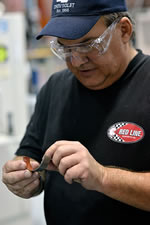Is this a Dream or is that really my LS7? Page 4 of 10
Is this a Dream or-is that really my LS7?
CAC Does the Corvette Engine Building Experience - Page 4 of 10
by Hib Halverson
© September 2012
No use without permission, All Rights Reserved
Problem Solving
After the main cap bolts were tight, Mike gave the crank a turn using a wheel-like turning tool installed on the crank snout. He frowned, grasped the wheel more securely and twisted it, again. "That doesn't feel right," he said uneasily. I turned the crankshaft and felt a slight increase in resistance for about a third of a revolution. Uh-oh, not good. I thought.
"Something's not right. We shouldn't feel that tight spot. Let's tear it back down." Mike said. I think I sensed a fleeting moment of anxiety when he said that. Was he thinking that this kind of thing just doesn't happen during the "Corvette Engine Build Experience"-especially when the one experiencing the build is, also, writing an article about putting his LS7 together?
"If I was doing this motor in my shop, I'd pull it back apart,"I agreed.
This was great stuff. I was seeing one reason why the PBC was originally conceived-an expert assembler catching a seemingly minor problem which might slip though in one of GM's fast-moving, automated, high-volume engine plants. The problem with such "minor problems" is, with very high-performance engines like the LS7, when ignored, once in a while, they become major problems. I don't want major problems.
Mike walked over to the next assembly line and talked with another builder working on an LS9 then headed towards the PBC's office suite. He returned in a few minutes saying we swap the main bearings and the crank. I started unbolting the main bearing caps. Later Mike stepped in and swapped the parts.
With a fresh set of mains and a different crankshaft, the tight spot was gone. A bit later, Rob Nichols came by with a main bearing shell. "See that," he said-I had to take a second to look real close. I saw a tiny pink scuff in the red polymer coating. "That little high spot was causing the crank to tighten up."
"I'll bet that's a thousandth or so," I mused, looking at the bearing.
"That's all it takes," Rob continued. "Maybe it would have just worn away but, we don't take chances."
Ok. You're wondering about the polymer. Starting with the 2012 model year, in response to new legislation in the European Union banning the importation of products containing lead, GM's bearing supplier replaced the lead overlay on the tri-metal bearings, used for the number 1, 2, 4 and 5 main bearings and all the connecting rods in an LS7, with an anti-friction polymer coating similar in nature to what's been used since 2002 on piston skirts. Apparently, they are now "polymer-coated, bi-metal" bearings. This new coating is applied using a spray process and, according to Nichols, the learning curve for consistent application has been steep. "We have seen some bearings with thicker polymer on them than others," Nichols in an interview conducted after my engine build, "but that has gotten a better as time has gone on and the supplier has honed their process for applying the polymer coating."
So, you're wondering-how does a bearing shell with a little fleck of a high spot get though? I'm glad you asked because, I was the guy who inspected all the main and rod bearing shells before my engine assembly began. Reality is: no way could anyone see a .001-.002-inch high-spot in the coating. To have found it, we would have to have been measuring the thickness of the entire surface of each bearing with a micrometer-obviously impractical, even at the PBC. The only way such a problem could be detected is exactly the way we found it-experienced engine assemblers, like Mike Priest, turning the crankshaft by hand and feeling a slight resistance.


